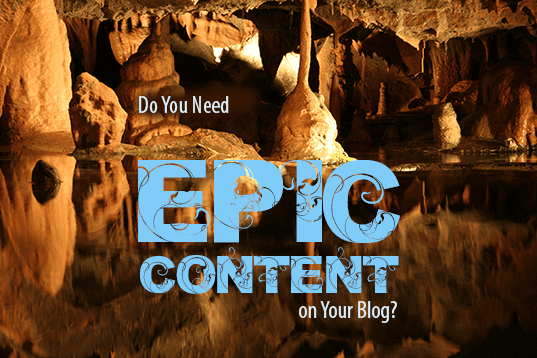Remember a few years ago when blogs started creating epic posts?
I first heard the term around 2011 or so. A few years later, they became standard among business blogs—I now think of 2013 as The Year of the Ultimate Guide.
These days you see fewer “ultimate guides,” but epic is still a goal. Some experts even suggest all blog posts should be 2000+ words.
That’s because epic content tends to attract traffic and build authority.
The trouble is it also takes a lot of time and money to produce. Is it worth the investment? Let’s take a look.
First, what is “epic”?
Mention epic and most people immediately think long—3000+ words.
That sets the bar really low, though, don’t you think? Anyone can throw words on a page until a word count has been met.
To be truly epic, content should resemble an epic journey. It should take you places you’ve never been before and explore a topic in-depth, both deep and wide.
I’m visualizing a cave. You, the content creator, are the explorer, wandering into the vast unknown and reporting your findings.
To do that, you shine your light on different areas—the floor in front of you, the walls around you, the stalactites and stalagmites—and describe what you see.
Epic content uses a bright light and describes every crack, every mineral lode, every change in terrain.
That’s why it tends to build authority. You can’t give that much detail unless you’ve been there.
Here’s what sets epic content apart:
- It goes deep and/or wide. The best does both.
- It’s well organized, so it’s easy to skim and still grasp the logic behind your presentation.
- It uncovers new insights or explains precise steps to achieve a goal.
- It offers value to readers: solving problems, giving actionable advice, answering questions.
Impressive, sure, but does it work?
All content should have a goal. In most cases, the goal of your blog is to drive subscriptions.
Individual articles may have other goals, such as sending traffic to a landing page or getting people to register for a course or event.
The goal for epic content is primarily traffic and branding (building your expert status). It also tends to increase subscriptions, since it positions you as an authority on the topic and anyone interested in the topic will want more of the same.
Does it achieve these goals?
Maybe. Maybe not.
Neil Patel was one of the first to leverage advanced guides on his blog. He produced a series of them to increase traffic on QuickSprout. One of them, The Advanced Guide to Content Marketing, I co-authored.
These guides were a big hit. As each was published, I saw his following grow and his personal brand soar. Clearly, epic content was working for him.
Now, it’s important to note that he was doing it extremely well. He invested heavily in writing and design to make sure the final product was the highest quality. Few other brands could (or would) afford to do that.
But that’s what makes him an interesting case study.
After a year of epic publishing, here’s what he told me: His advanced guides impacted traffic over the short term, but over the long term, they didn’t make that much of a difference.
In other words, if you try to drive traffic with epic content, you’ll have to continue creating epic content to maintain those numbers. It probably won’t make as big a difference as you thought it would.
Is epic content worth the effort?
Based on Neil’s evaluation of his advanced guides, I’d say you need to define your terms before you begin producing epic content.
Neil felt that the traffic boost wasn’t sufficient to justify the expense of his guides. But he got a terrific boost to his personal brand, and that resulted in speaking engagements and industry recognition, among other perks.
From a traffic standpoint, they may have been a wash. But for branding, they were a win.
Here’s another example…
Last year I produced this post on Crazy Egg: “The Ultimate Guide to Finding and Using Images in Your Content.”
This is an ebook formatted as an epic post. It’s nowhere near the level of Neil’s guides, but it does qualify as an epic post.
The cost? I wanted about 4 times the length of a regular post, so I paid my writer 4 times the usual cost of a post. To keep costs down, I did the design work myself.
But there were other costs as well. The month the ebook was in production and the following month, I struggled to meet my content production goals for the blog. The first month, instead of producing her usual 3 articles, my writer only wrote this one. And it took another month for us to get back to our usual routine.
Then, instead of spending a few hours editing and producing this post, I spent a few days on editing and layout in addition to my usual pre-publication tasks.
This epic post took 4 times the time and 4 times the budget that an ordinary post would get. It should have returned at least 4 times the results.
It has been one of our most popular posts and continues to get social shares and comments. Did it get 4 times the traffic? No. Did it impact our brand? No. (I didn’t get any speaking engagement from it either. lol)
If I’m honest, this piece of epic content didn’t reach my goals. And it only just paid for itself. Results justified the extra cost—but not the extra time and stress of producing it.
Alternatives to an epic guide
For comparison’s sake, it’s worth noting that Seth Godin gets a lot of traffic with short blog posts of 100-400 words.
He simply shares a great idea. No fluff. No fanfare. Just a quick post that’s worth thinking about for a day.
While epic posts look impressive, I don’t believe they’re the end-all in content marketing. I think you could get more value from a book or a video series and a well-written blog.
In my opinion, what we’re calling epic is simply long. You could easily get as much value from quality, regardless of the length.
The real value of any content comes from:
- The quality of your ideas
- The quality of your research
- How well you present your findings
- How useful it is to your readers
Value doesn’t come from length.
Given the low return on the investment in epic content—financial, time and energy—I think you could raise the quality of your regular blog posts and do just as well.
Let me explain.
Epic content is highly detailed, in-depth content that generally covers every aspect of a topic. But if you’re trying to produce epic content, all that detail gets poured into one article.
You could easily create a series of posts that give the same detail—but publish them over a period of time. Doing it this way, one “chapter” gets published each day until the topic is fully covered.
You won’t strain your content production, your budget or your time, but you’ll produce top-quality content that ranks well in search and attracts readers and social shares.
All it takes is changing your definition of epic from long to quality. Invest in better writers. Take time to produce better graphics. Make your 1000-word posts as epic as your 3000-word posts.
I’d be willing to bet you’ll get the same results as you would with an ultimate guide, but without the headache.
What are your thoughts? Are you enamored with epic content or have you found a better way to reach your goals?



